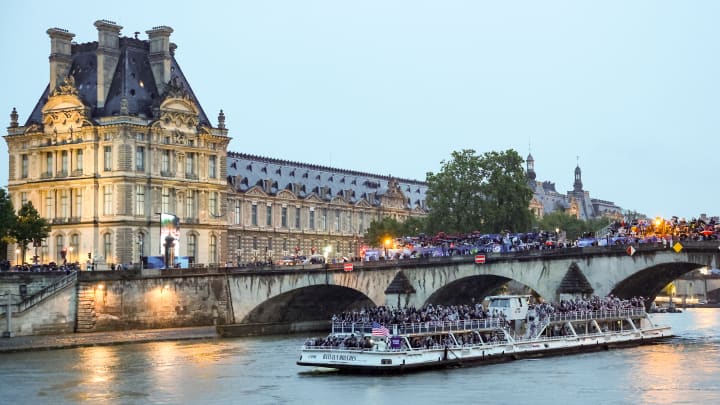My Day Along the Seine River at the Olympics Ended with a Swim

SOMEWHERE ALONG THE SEINE — A day along the Seine begins as the sun rises over Paris. The streets are nearly empty, but for joggers getting in their morning miles and revelers, including two dudes dressed in togas, leaving establishments just in time for church.
This is the country’s third-longest river, but the heart of its capital—that’s why Parisians staged the Opening Ceremony there. It’s named after Sequana, a Celtic goddess. It begins 18 miles northwest of Dijon, flows northwest through Paris, then empties into the English Channel at Le Havre. It’s 485 miles long. The bond between the City of Lights and the river that runs through it has deepened since the Middle Ages. As part of the foundation of the French Monarchy. As the hub of the nation-state. As a landmark of France for the world. As inspiration for the famous paintings that hang in the museums just beyond its banks. As a source of hydroelectric power and a drinking source for half of Paris. And now, as the center of the Olympic Games.
But despite its importance, the Seine has something of an image problem. Yes, it represents one of the most beautiful cities on the planet, and yes, it is the face of the Games to the world, but it also represents … water so polluted that swimming was banned in it for the last century. So, Paris Olympic organizers decided to invest $1.5 billion in cleaning up the river—and its image. They promised to make the Seine safe enough for Olympic triathletes and open-water swimmers to compete in. (On Monday, officials cancelled the swim portion of triathlon training for a second straight day due to concerns about the water quality.)
Short of swimming its length—and I’ll leave that to Olympic athletes and mayors—maybe the best way to tell the story of this all-important waterway is, ironically, to walk it.
6:58 a.m.
I start my Day Along the Seine at sunrise in Montmartre. In my mind are the words of Roman philosopher Marcus Aurelius, who loved river metaphors as much as Noah Lyles loves Yu-Gi-Oh! cards:
Meditate often on the swiftness with which all that exists and is coming into being is swept by us and carried away. For substance is like a river’s unending flow, its activities continually changing and causes infinitely shifting so that almost nothing at all stands still.
7:55 a.m.
A man in a long-sleeved T-shirt with USA across the chest rides a Lime Bike, following closely behind an athlete, in a scene out of Mike Tyson’s Punch-Out!!. Another runner jogs on the pavement near the river’s edge. Asked what he makes of this river and its Olympic importance, he says, “Isn’t it polluted?”and keeps running.
Yes, it is. Or it has been. So why hold Olympic events on the Seine at all?
Maybe it’s the history, the narrative arc, or for the plot. The first time Paris hosted an Olympics was 1900, the second iteration of the modern Games, and swimming events unspooled in an even more polluted Seine. The second time the city hosted, in 1924, was one year after swimming was banned in the river, so events were held in the Piscine des Tourelles—an actual pool.
Olympic competitions now rest on E. coli measurements and uncontrollable acts of nature, like the rain that fell on Friday and Saturday. Rain overwhelms the treatment facilities, and allows more bacteria to frolic in the water. The mayor jumped in two weeks ago, but only after pushing the date back until levels were “acceptable.” A heavy rain later and she would not have dared dip a toe in. British athletes have been vaccinated for typhoid and hepatitis A and will take antibiotics after competition. This is assuming the water is declared “safe enough” for the two events in the Seine—the triathlon and the 10km open-water swim. If not, those races will be held in the Vaires-sur-Marne Nautical Stadium, site of the rowing competition.
The decision will be made on the day of the race. So, after years of preparation, triathletes and marathon swimmers will not only have no opportunity to practice in the Olympic venue, they also won’t even know what that venue is.
8:42 a.m.
I went in search of the true heart of the Seine, away from the bends and straits where Olympic officials staged the opening ceremony, far from the scores of police officers, security guards and volunteers who protect its banks. One man, in one boat, told me:
“This river,” the man said, “this is my life!”
He stopped there, then added, with a dismissing wave, “You go now.”
As with the clean-up of the Thames before the London 2012 Games, the argument for sanitizing the Seine was not to clean up the river for the Olympics but for life afterward. Not only did France build a water-treatment plant and a holding tank for untreated overflow water, it also established regulations for houseboats, requiring owners to use the municipal sewer system, and upgraded sewage pipes. Government officials have said they want to reconnect the river and the people. But couldn’t those measures have been taken without forcing swimmers and triathletes into the Seine? In London, they swam in the Serpentine in Hyde Park, not the Thames.
10:11 a.m.
As the rest of Paris awakens on a sleepy Sunday, the Seine is already pulsing with activity—joggers, bike riders and tourists on their way to museums, monuments, shopping districts, and bistros. Locals sit near the river, drinking beer. Police boats cruise upstream and down. Trucks power-wash the pavement on nearby streets. Several pubs are already open. There’s a vibe: For tourists, locals, businesses, boat captains, fishermen, even the brave few who dare a quick plunge—this river is theirs.
1:25 p.m.
Close by the river lies the Olympic Village, which actually spans three cities (Saint-Denis, Saint Ouen and L'Île-Saint-Denis). Some 14,250 Olympic athletes and 8,000 Paralympic ones will be housed and fed there.
According to Olympic organizers, the Village will “transform” the neighborhood around it: 2,500 new homes, a dormitory for students, a hotel, a park, space for businesses and city service offices and room for shops. This sounds great and it isn’t insignificant, but to clear the ground for the construction, officials closed homeless encampments and shipped those who lived there farther out of town. Now, this part of the Seine looks pretty much like … Brooklyn, with fancy coffee spots and artisanal gastropubs.
Host cities do change with the Games, often for the better and sometimes for the worse. It would have taken East London a century to redevelop in the same way it did because of the Olympics. The question is whether the Seine will be a success story for Paris like the Thames was for London.
2:45 p.m.
Head west from the Olympic Village, through Paris, and then away from it, toward Bondy and surrounding towns. The Seine here seems untouched by the Olympics. Near river entrances, groups of teens hang out on corners. Empty lots, once home to some encampments, are now just dirt and garbage waiting to be refashioned.
A man rides a dirt bike up and down one street, popping wheelies through the intersection. Gates guard nearly every apartment complex; some with barbed wire on the top of thick fences, residents sheltered behind heavy bolts and iron gates. The letters on a sign for one college here has almost worn off. Two faded French flags flap in the breeze.
There are no police here. No Olympic security. No benches to sit and watch the sunset. No paths to a famous museum. There’s a Western Union. River banks overgrown with weeds, unpaved; graffiti, some remarkable, drawn on every surface.
A woman camps in the shade. She wears a yellow Brazil T-shirt. She says her name is Camille and that she lives here because she has no other choice. “The Olympics,” she says, “are not for me.”
A few hundred feet downstream, a family camps along the river’s edge. They’re washing clothes in a small, clear storage tub. A man sits nearby, at the water’s edge, huge beard, shirtless, lost in thought. He is meditating, perhaps channeling Marcus Aurelius, as the river bends and flows before him. Smoke curls from a small, portable grill. Some men fish; others guide along small sailboats. A woman pedals by, narrowly avoiding a black cat scurrying in her path. A Husky runs toward the water, as if he’ll surely jump in, then stops. Even the dog knows. Kidding. Sort of.
Cigarette butts, broken bottles and, in one instance, a pile of excrement pool on the concrete. The transformation of some neighborhoods, the ones around the Olympic Village, is nice and all. But for the people here, maybe it would be nicer if it were their neighborhood, the one that hasn’t changed, the one that doesn’t appear likely to change any time soon.
No one says that on this Day Along the Seine, though. On this part of the river, no one is talking about the Olympics. Their Seine is just a river, not a symbol.
3:22 p.m.
There’s a man on the river’s edge near Bondy. He’s a Yankees fan. Of course. Can’t escape those, even in Paris. Eventually, he gestures toward the water. Maybe it’s hubris, a lapse in sound judgment, a challenge accepted. But in the moment, the answer is why not? We step toward the edge … laugh uncomfortably … and … jump.
It’s not the plunge that I imagined. The water is cold, borderline arctic. It’s greener too, and home to far more garbage, weeds and muck than the Paris portion. It’ll wake you up, to be sure, and so will the man’s screams.
My river! My river!
I ask, “What’s your name?”
“Aaron Judge,” he says, cackling as we climb out and dry off and, of course, pray for no infections.
There’s a fairly well known poem, penned by an American, Delmore Schwartz, titled Seurat’s Sunday Afternoon Along the Seine. It’s long and beautiful and descriptive, but the best part, the most relevant part to these Olympics, comes at the very beginning.
What are they looking at? Is it the river?
The sunlight on the river, the summer, leisure,
Or the luxury and nothingness of consciousness? …
Everyone holds his heart within his hands …
The Sunday people are looking at hope itself.
The organizers were right: The Seine does represent Paris, but all sides of Paris. Its purpose and importance vary depending on the viewer. Residents see the river, hear of the improvements and hope for a better future. Visitors see the river, hear of its pollution and hope for the best for the athletes.
The Seine’s part in Paris’s Olympic legacy cannot be determined for years.
Back to the poem.
This is the nervous reality of time and time’s fire which turns
Whatever is into another thing, continually altering and changing all I
dentify, as time’s great fire burns (aspiring, flying and dying),
So that all things arise and fall, living, leaping and fading,
falling, like flames aspiring, flowering, flying and dying –
Within the uncontrollable blaze of time and of history:
6:53 p.m.
As the sun drops toward the horizon, sunset still a few hours away, Nations Park materializes in La Villette like a desert mirage. Home to Club France, Canada Olympic House, Casas Brazil and Colombia and Mexico, the Czech House and so many other nations’ houses, a playground, a carousel, colorful sculptures, bars, restaurants and beer gardens. A gathering place for Olympic obsessives from all over the world. It’s part celebration, part carnival, part circus. It’s festive. Mostly, it feels like the Olympics, almost like, ahem, organizers planned the vibe to come across that way. And, like so many other parts of these Games, the whole thing runs along the Seine.
